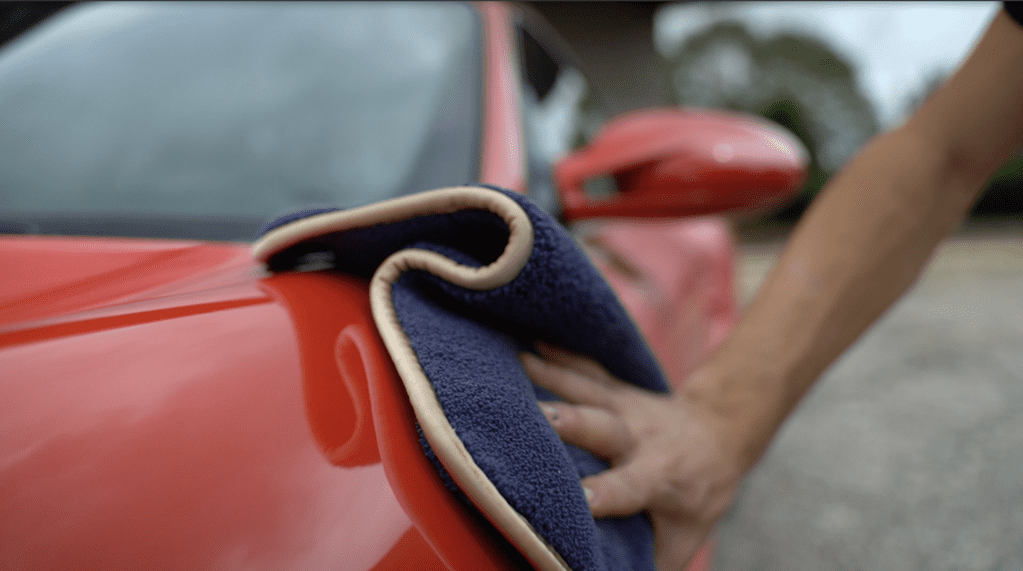
When cleaning your car, it may be tempting to use a bath towel or kitchen towel instead of a microfiber towel. Do you really need to use a microfiber towel when cleaning your car?
As a general rule when making contact with any paint on your car, you should be using microfiber to prevent scratching. This can be in the form of a microfiber sponge, towel, cloth, Etc. Using a bath towel or kitchen towel may not look like it is damaging your paint. But over time the micro-scratches and swirls will leave your paint looking dull. Microfiber cloths pick up debris and other contaminants that could scratch your paint, instead of pushing debris into your paint, scratching the paint.
Want to know more about microfibers and preventing scratching on your paint? Keep reading to learn everything you need to know!
The Importance of Microfiber Cloths
As a professional detailer, I use microfibers for everything. This includes the interior, exterior, and engine bay. On the interior, microfiber cloths can help trap any dust or debris left on surfaces. Microfiber also picks up 99.9% of surface-bound bacteria, helping sanitize your interior. On the exterior microfibers help protect the shine of your paint by preventing scratching.
Microfiber cloths, towels, and sponges are typically made of a synthetic blend of polyester and polyamide. This synthetic blend creates a static electric charge, attracting dirt, dust, and debris therefore using a microfiber will leave you with a lint and dust-free surface.
Microfiber also traps debris inside its fibers, protecting your paint from scratches. This is done with a star-shaped fiber that is thinner than hair. This star-shaped fiber helps capture and lift any debris off your paint. Cotton towels instead have a round fiber, that pushes debris into the paint, causing scratches.

Microfiber cloths can be washed and reused, as long as they are properly maintained. For this reason, I recommend investing in high-quality microfiber cloths and towels that will last you a few years.
Choosing A Microfiber
When it comes to choosing a microfiber towel there are several different options. Some popular types of microfiber towels are:
- Plush (Polishing)
- General Purpose
- Waffle Weave
- Drying Towel
When checking the quality of microfiber cloths, the main things to check are the weight and thickness. Higher-quality microfiber cloths are thicker and heavier, allowing them to pick up and hold more debris. An easy test to ensure quality is holding the cloth up to a light if light passes through its low quality.
When polishing, waxing and most other times you will be touching your car paint, you want to use a plush polishing microfiber. These polishing cloths will help protect your paint by barring debris inside its longer fibers. I recommend buying an edge-less cloth for any paintwork to prevent scratching. to learn more about protecting your car’s paint check out this article!
General-purpose microfibers are the type you often buy in a pack of 20-50. With shorter fibers, you should use these for everything other than paint. These are good for cleaning the interior, and engine bay, as well as buffing glass. With shorter fibers, some debris can get picked up, but still, be exposed to scratch your paint. For this reason, I only recommend using general-purpose microfibers on fully decontaminated paint to prevent scratching.
Waffle weave cloths are used for cleaning glass. With extremely short fibers, this cloth allows you to remove any oils and grease from glass. The weaved surface allows the towel to efficiently trap and evaporate water, leaving a streak-free finish. To learn more about washing windows check out this article!
One of the most important towels is your drying towel, because any water left to dry on paint or glass may leave spots. A good drying towel should absorb a substantial amount of water, fully drying one if not two cars. These towels often have longer fibers, like the plush cloths, to help protect your paint from scratches.
Maintenance of Microfiber Towels
When it comes to maintaining microfiber cloths, keeping them clean is key. You should treat your microfiber cloths like tape, if they touch the ground and pick up debris they should be thrown away. This is due to their tendency to hold onto any debris they touch. For this reason, I recommend having a clean place to store both your clean and dirty microfibers.
When cleaning microfiber cloths, it is important you do not mix them with other fabrics. If washed with other towels or clothing, they will hold on to unwanted lint and debris. I recommended separating and washing your towels based on their use:
- Wheel and engine bay
- Polishing
- Paint
- Interior
If any of your microfiber cloths have oil or are really dirty, you can presoak them in a water and degreaser mix. This can be done in a bucket or a sink with lukewarm water and a splash of degreaser. Allow this to soak for a few hours before washing.
There are detergents designed for cleaning microfiber cloths, there is an option at Walmart. Any gentle detergent free of dye, sent, fabric softener or bleach can be used. Additives such as fabric softeners or scents can leave a film on your microfiber cloths, later causing streaking.
Once ready to wash, make sure to wash on normal with cold or warm water. Using hot water runs the risk of melting the fibers and ruining the cloth. You can add half a cup of distilled white vinegar to either the bleach or fabric softener section of your washing machine. This will help free up any debris that is caught up in the microfiber cloths.
To dry the microfiber cloths, dry them in the dryer on low or no heat. The tumbling allows the cloths to regain some electrostatic charge, improving their effectiveness. It is important not to use dryer sheets, as these can remove the electrostatic charge.
